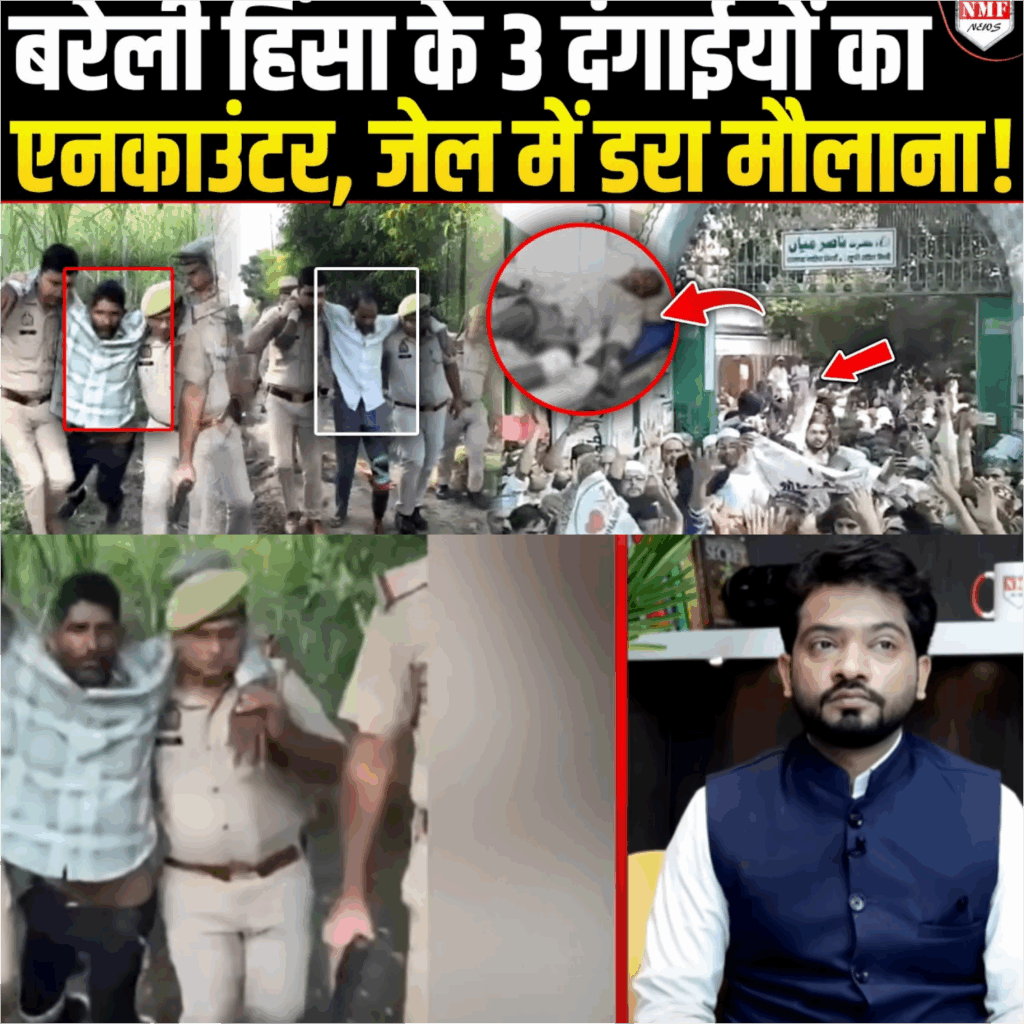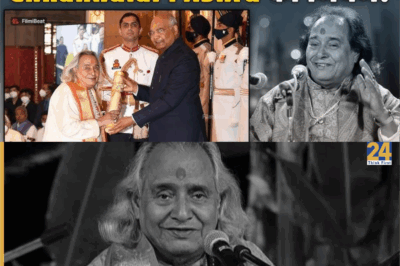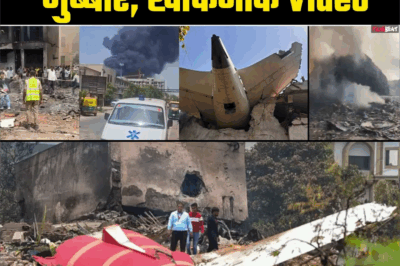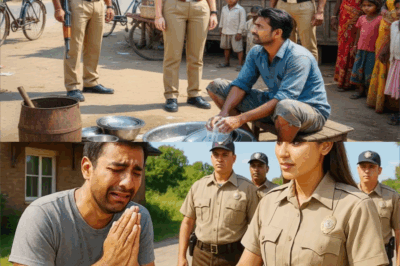पुलिस पर फायरिंग करने वाले 3 आरोपियों का एनकाउंटर, योगी की चेतावनी से बाकी दंगाईयों में भरा ख़ौफ़!
.
.
Police Encounter of Three Accused in Bareilly Violence: Yogi’s Warning Instills Fear Among Rioters
Bareilly, Uttar Pradesh, October 2025 – The city of Bareilly has found itself at the epicenter of a major law and order operation following recent communal violence. In a series of rapid police actions, three accused individuals involved in firing at police officers during the unrest have been shot and apprehended, sending a strong message to those who might seek to disrupt peace in Uttar Pradesh. The state government, led by Chief Minister Yogi Adityanath, has adopted a zero-tolerance approach, combining technological surveillance, bulldozer actions against illegal encroachments, and now, police encounters to curb unrest.

The Incident: Violence Erupts in Bareilly
The violence began on September 26th in Bareilly’s Kotwali area during a religious gathering that quickly spiraled out of control. According to police reports, a group of miscreants began pelting stones and opened fire on law enforcement personnel. In the chaos, one police officer’s government-issued anti-riot gun was snatched, further escalating the situation. Several police officers and civilians were injured as the mob clashed with law enforcement.
The police responded with swift action, analyzing CCTV footage, social media messages, and eyewitness accounts to identify those involved. Initial investigations revealed that the violence was not solely the work of local elements; several accused individuals were found to have traveled from outside Bareilly, including from Shahjahanpur, Bengal, and Bihar, raising concerns about premeditated external involvement.
Police Action: Encounters and Arrests
Within days, the police tracked down and confronted three main accused: Idris, son of Siddiq, and Iqbal, son of Zafar Ali—both residents of Shahjahanpur—as well as another local, Tajim, previously jailed for cattle smuggling and under the Gangster Act. In separate police encounters, all three sustained gunshot wounds to the legs and were promptly admitted to local hospitals for treatment before being taken into custody.
From the accused, the police recovered two illegal country-made pistols, several live cartridges, a snatched government anti-riot gun, a motorcycle, and two mobile phones. During interrogation, it emerged that a known criminal, Nadeem Khan (already in jail), had coordinated with the accused to orchestrate their presence and actions during the violence.
Both Idris and Iqbal had lengthy criminal records, with 20 and 17 cases respectively, ranging from theft and robbery to violations of the Gangster and Arms Acts. Their repeated involvement in criminal activities highlighted the challenge faced by law enforcement in tackling habitual offenders who are often at the center of such unrest.
Yogi Adityanath’s Stern Warning
Chief Minister Yogi Adityanath responded to the violence with a clear and uncompromising message: “No rioter or mischief-maker will be tolerated in Uttar Pradesh. Anyone attempting to disturb the peace will face strict action.” His remarks, directed especially at Maulana Tauqeer Raza—alleged to have incited the crowd—were widely publicized. “Perhaps he has forgotten in which state he is standing and acting this way,” Yogi warned, emphasizing that the state would not hesitate to take action against those who try to mobilize crowds for unlawful purposes.
The approach is in line with the Yogi administration’s ongoing campaign against crime and disorder, which has included the use of bulldozers to demolish illegal encroachments linked to criminal activity. The recent shift towards police encounters, especially in high-profile cases, is seen as an escalation intended to deter potential rioters and criminals.
Technology and Surveillance: The New Tools of Policing
A significant aspect of the police response has been the deployment of advanced technology, including AI-enabled high-definition cameras capable of identifying individuals in crowds of thousands. Police sources revealed that, unlike in the past, they are now able to extract and analyze facial data from chaotic scenes, ensuring that even those who attempt to hide in large groups can be identified and held accountable.
This technological edge was notably absent during previous incidents, such as the anti-CAA protests, where identifying individual culprits in large crowds proved challenging. The current case marks a turning point, with police confident that “no accused will escape, no matter where they try to hide.”
Political Reactions and Social Debate
The police crackdown has not gone unnoticed by political parties. The Samajwadi Party (SP), the main opposition in Uttar Pradesh, attempted to send a delegation to Bareilly, only to be stopped by authorities. SP leaders have voiced concerns that innocent people are being caught up in the police net, demanding that only those clearly identified through video and other evidence be arrested.
In response, the police held a press conference to assure the public that arrests are being made strictly on the basis of scientific evidence, including CCTV footage and digital forensics. “No innocent person will be harassed. If anyone feels they are being wrongfully targeted, they should immediately contact the authorities,” a senior officer stated.
The Role of Maulana Tauqeer Raza
Much of the controversy has centered on Maulana Tauqeer Raza, who is accused of inciting the crowd both through public speeches and alleged WhatsApp messages circulated prior to the violence. Critics argue that Raza, emboldened by past political patronage and a sense of impunity, played a key role in mobilizing not only local youth but also outsiders, including minors as young as 10-15 years old, many of whom may not have fully understood the consequences of their actions.
Raza’s history, including previous brushes with the law during the 2010 Moradabad riots, has fueled demands for his arrest. While earlier governments are accused of hesitating to act against him, the current administration appears determined to hold all alleged masterminds accountable.
Bulldozer Action: Targeting Illegal Encroachments
Alongside the police operations, the government has intensified its “bulldozer action” against illegal encroachments. Properties and land illegally occupied by those linked to the violence—regardless of their family or political connections—are being demolished. The message is clear: no one, whether a relative or an associate of a rioter, will be spared if found violating the law.
This approach, while controversial, has been popular among sections of the public who see it as a necessary step to restore order and deter future unrest. Critics, however, warn of the potential for abuse and the need for due process.
The “I Love Mohammad” Slogan Controversy
Amid the violence, a new controversy erupted over the use of the slogan “I Love Mohammad,” which some participants displayed. Islamic scholars interviewed on national television expressed concern, arguing that such slogans are not in keeping with religious tradition and may even be considered disrespectful if not accompanied by the proper honorifics. The debate has highlighted the ways in which religious sentiment can be manipulated for political or disruptive ends.
Looking Ahead: A State on Alert
As of now, the situation in Bareilly remains tense but under control. Police continue to search for remaining suspects, vowing that “no guilty person will be spared.” The administration’s actions have instilled a palpable sense of fear among those who might consider participating in future unrest, a development that supporters of the government see as essential for maintaining peace.
However, questions remain about the long-term impact of such measures. The use of encounters, bulldozers, and mass surveillance raises concerns about civil liberties and the possibility of innocent individuals being caught up in the dragnet. The opposition continues to demand transparency and accountability, while the government insists that only the guilty have reason to fear.
Conclusion
The Bareilly violence and its aftermath represent a critical moment in Uttar Pradesh’s ongoing struggle with communal unrest and law enforcement. The Yogi government’s aggressive response—combining technology, police encounters, and property demolitions—has sent a powerful message to potential troublemakers. Yet, as the dust settles, the state must also grapple with the need to balance security with justice, ensuring that the rights of all citizens are protected even as it seeks to maintain order.
For now, Bareilly stands as a testament to the changing face of policing in India’s largest state—a place where, as Chief Minister Yogi Adityanath has made clear, “no one who disturbs the peace will be tolerated.”
.
News
कोच्चि दहल उठा: मछली पकड़ने वाली नाव के डिब्बे से 36 शव बरामद, सीमा पर छिपा चौंकाने वाला सच
कोच्चि दहल उठा: मछली पकड़ने वाली नाव के डिब्बे से 36 शव बरामद, सीमा पर छिपा चौंकाने वाला सच ….
एक अरबपति एक टोकरी में एक बच्चे को पाता है और सच्चाई उसे हमेशा के लिए उसकी नौकरानी से जोड़ देती है
एक अरबपति एक टोकरी में एक बच्चे को पाता है और सच्चाई उसे हमेशा के लिए उसकी नौकरानी से जोड़…
Avika Gor’s grand Wedding with Milind Chandwani on National TV with Tv Actors and Family
Avika Gor’s grand Wedding with Milind Chandwani on National TV with Tv Actors and Family . . Avika Gor and…
Chhannulal Mishra: Classical music legend Chhannulal Mishra passes away, last rites to be performed in Kashi!
Chhannulal Mishra: Classical music legend Chhannulal Mishra passes away, last rites to be performed in Kashi! . . India Mourns…
Ahmedabad Plane Crash: Plane going from Ahmedabad to London crashes, many people died, horrifying video of the accident
Ahmedabad Plane Crash: Plane going from Ahmedabad to London crashes, many people died, horrifying video of the accident . ….
SP मैडम खाना खाने ढाबे पर पहुँची ; तभी तलाकशुदा पति बर्तन धोते मिला फिर मैडम ने जो किया …
SP मैडम खाना खाने ढाबे पर पहुँची ; तभी तलाकशुदा पति बर्तन धोते मिला फिर मैडम ने जो किया ……
End of content
No more pages to load










